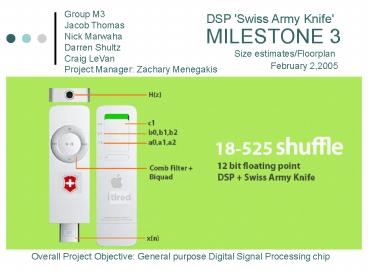Potential Swiss Army Knife Applications
Title:
Potential Swiss Army Knife Applications
Description:
Digital Radios / MP3 Players (i.e. Motorola, Lucent, Texas Instruments) Digital Music Synthesis / Sampling (i.e. Yamaha, Korg) Noise Reduction (i.e. Dolby) ... –
Number of Views:34
Avg rating:3.0/5.0
Title: Potential Swiss Army Knife Applications
1
Group M3 Jacob Thomas Nick Marwaha Darren
Shultz Craig LeVan Project Manager Zachary
Menegakis
DSP 'Swiss Army Knife'
MILESTONE 3 Size estimates/Floorplan
February 2,2005
Overall Project Objective General purpose
Digital Signal Processing chip
2
STATUS
- Design Proposal (Done)
- Architecture (Done)
- Size Estimates/Floorplan/Verilog (90)
- To Be Done
- Structural Verilog Reengineering
- Control Logic
- Low-Level Modules
- Schematic
- Verification
3
MARKETING UPDATE
- How Does Our Circuit Fit Into the Bigger Picture?
- Focus on Audio/Video Applications
- Audio
- Digital Radios / MP3 Players (i.e. Motorola,
Lucent, Texas Instruments) - Digital Music Synthesis / Sampling (i.e. Yamaha,
Korg) - Noise Reduction (i.e. Dolby)
- Video
- Comb Filter to separate color and brightness
(i.e. Sony, Toshiba) - Others
- Motor Control Functions such as RPM (i.e. Ford,
GE)
4
MARKETING UPDATE cont
Highlighted Areas Contain Many Instances of our
Circuit
Key Functions used Integrators and Filters
REUSE!!!!
5
MARKETING UPDATE cont
- A Moving Averager Smoothes a Signal to Reduce
Noise
6
DESIGN DECISIONS
- Finalized bit-width to 12-bit floating point
- Based on CMU Research in Voice Recognition
- Complexity gt Our Applications in Audio and Video
- 6-bit exponent, 5-bit fraction
- Additional Precision cannot be discerned by
humans - Reduces Power Consumption
- Increased bit-width does not add to
quality/versatility - Chip Applications would benefit from low power
consumption - Size offers advantages of parallel processing to
increase speed - Serial (software) vs. Parallel (hardware)
operations
7
DESIGN DECISIONS cont
8
DESIGN DECISIONS cont
Name a0 a1 a2 b0 b1 b2 c1 N
1 Differencer 1 0 0 1 -1 0 0 x
2 Integrator 1 1 0 1 0 0 0 x
3 Leaky Integrator 1 1 0 1 0 0 0 x
4 Comb Filter 1 0 0 1 0 0 1 8
5 Bandpass Filter 1 0 -1 1 0 0 1 16
6 CIC Interpolation Filter 1 1 0 1 0 0 1 8
7 dc Bias Removal 1 a.b 0 1 -1 0 0 x
8 First-Order Equalizer 1 a.b 0 a.b 1 0 0 x
9 Audio Comb 1 0 a.b 1 0 0 0 x
10 Moving Averager 1 1 0 1/N 0 0 1 8
11 Second-Order IIR Filter 1 a.bbb a.bbb a.bbbb a.bbb a.bbb 0 x
12 First-Order Delay Network 1 a.bbb a.bbb a.bbb a.bbb 1 0 x
13 Second-Order Delay Network 1 a.bbb a.bbb a.bbb a.bbb 1 0 x
14 Real Oscillator 1 2cos(x) -1 1 0 -1 x x
15 Second-Order Equalizer 1 (a.bcos(x) a.b 1 a.bcos(x) 1/a.b 0 x
16 Real FSF, Type I 1 2cos(x) -1 ?cos(x) ?cos(x) 0 1 x/2pik
17 Real FSF, Type IV 1 2cos(x) -1 ?1 0 ?1 1 x/2pik
18 Complex FSF 1 imag 0 1 0 0 1 x/2pik
19 Quadrature Oscillator G(n) imag 0 1 0 0 x x
20 First-Order IIR Filter 1 imag 0 1 imag 0 0 x
21 Goertzel Network 1 2cos(x) -1 1 imag 0 0 x/2pik
22 Sliding DFT Network imag 1 0 1 0 0 rN x/2pik
9
FLOORPLAN
Each block is approximately 100 100 with the
exception of the possibly larger comb filter
10
FLOORPLAN alternative
11
POROSITY
- STOLEN FROM W1 2004
- (Thanks Myron Bobby)
12
SIZE ESTIMATES
- Adder 5 (200 200 100) 2500
- Mult 7 (900200) 8000
- Div 2 (1000 200) 2400
- Fmult 1 (1200) 1,200
- Misc (700 250) 2,000
- Registers 83 22 1,900
- 18,000 transistors
13
VERILOG
14
PROBLEMS QUESTIONS
- Determine Bit Width
- Floorplan Minimize Comb Filter or use
Alternative? - Should Focus Be Area or Global Routing?
- Structural Verilog
- Fix Control Logic within Basic Blocks































